|
Current Issue - Spring/Summer 2013 Show Back Issues |
|
||
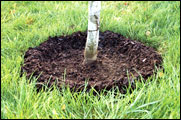 A doughnut effect around the tree trunk is the desired look when applying mulch.
A doughnut effect around the tree trunk is the desired look when applying mulch.
"To Mulch or Not To Mulch?"To mulch or not to mulch — that’s an often asked question. For knowledgeable gardeners mulch is recognized as one of the most important cultural practices you can do for your plants. Maintaining your landscape plants in a healthy growing condition is important for your property value as well as the aesthetic benefit. A mulched landscape not only looks good, but also provides a wonderful environment for root growth. Benefits of MulchHelps maintain soil moisture. Evaporation is reduced, and the need for watering can be minimized. Helps control weeds. A 2- to 4-inch layer of mulch will reduce the germination and growth of weeds. Mulch serves as nature's insulating blanket. Mulch keeps soils warmer in the winter and cooler in the summer. Many types of mulch can improve soil aeration, structure (aggregation of soil particles), and drainage over time. Some mulches can improve soil fertility. A layer of mulch can inhibit certain plant disease. Mulching around trees helps facilitate maintenance and can reduce the likelihood of damage from "weed whackers" or the dreaded "lawn mower blight." Mulch can give planting beds a uniform, well-cared-for look. Application is important. Apply a 2 to 4-inch thick layer of mulch evenly out to the drip line of the tree or plant if possible. Leave a few inches or bare ground around the stem or trunk. Avoid applying mulch “volcanoes” or burying the trunk in mulch as this will cause the lower trunk to decay. The mulch ring should resemble a doughnut not a volcano. Once you have mulched, make sure your irrigation water penetrates and reaches the soil. Any water absorbed by the mulch will help in retaining soil moisture. What kind of mulch should you use? There are organic and inorganic kinds. Inorganics include lava rocks, landscape fabrics and river rock. If you choose this route and later decide to remove it or plant into it you will have a challenge. We recommend organics such as shredded bark, bark chips or composted material. Composted mulch is the most desirable and gives the greatest soil improvement benefit. Fresh or “green” wood chips last the longest but can rob nutrients from your soil so apply extra nitrogen with the mulch. If your tree had a say in the matter its entire root system would be mulched, so mulch wide but not too deep. 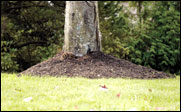 Avoid the "volcano" effect when mulching.
Avoid the "volcano" effect when mulching.
|
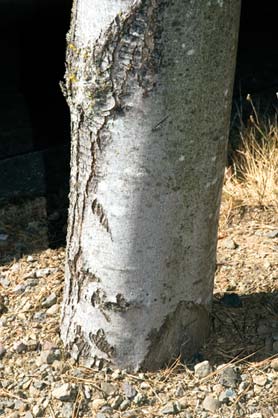 This Norway maple has been planted too deep and is susceptible to developing a girdling root.
This Norway maple has been planted too deep and is susceptible to developing a girdling root.
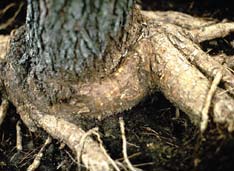
A girdling root is defined as a root that grows around the trunk of the tree — thus tending to strangle the tree. Girdling Roots: A Common Cause of Tree DeclineA girdling root is defined as a root that grows around the trunk of the tree thus tending to strangle the tree. Girdling roots act like an ever tightening tourniquet, restricting and cutting off the flow of water and nutrients. They are a common problem in the decline and death of ornamental trees planted in the landscape. Although the symptoms of girdling roots typically show up 15 to 30 years after the tree is planted, the problem generally starts when the tree is young. Research has shown that trees planted with their root flare too deep develop girdling roots. The root flare is the area at the base of the trunk that swells out to become a buttress for roots entering the soil. It is also known as the root collar. It is interesting to note that natural trees in the forest do not have girdling root problems. The most common tree species with girdling root problems are Norway and red maples, as well as pines. We have diagnosed many dying trees over the years with girdling roots and it is one of our most common causes of tree decline and death. Signs and Symptoms of Girdling RootsNo visible root flare at soil surface. The trunk descends straight into the soil with no flare. Trunk may be flattened on one side. Excavation of soil at trunk base may reveal the girdling roots. Leaves and annual growth are smaller than normal. Leaves may be scorched. Early fall color and leaf drop. Dieback in the crown of the tree. Sparse amount of foliage. PreventionPrevention begins at planting. Before planting, examine root system and remove encircling roots. For containerized trees, bare root and balled and burlap trees; remove or straighten encircling roots in a radial form. If the root collar flare is buried remove excess soil, then plant so the root flare is slightly exposed above ground. Consider rejecting trees if encircling roots are too severe or if the root flare is buried too deep. Treatment of Girdling RootsThe younger the trees the more chance of success you can expect with removal of girdling roots. As the tree gets larger and the encircling roots more severe, the removal of the roots must be balanced with the injury of the root removal. Many situations are so hopeless that it may be just a matter of time before the tree dies. To assess for the presence of girdling roots, either hand dig or use a soil excavation tool called an air spade. Girdling roots can be removed with wood gouges, saws or pruners. If more than one half of the circumference is severely compressed treatment is not recommended and removal should be considered. 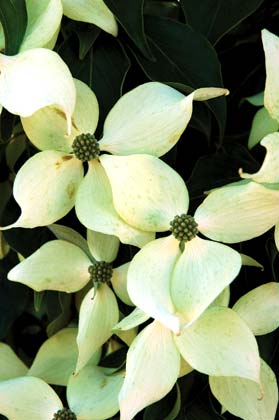 Flower petals are actually modified leaves called bracts that surround the true flower.
Flower petals are actually modified leaves called bracts that surround the true flower.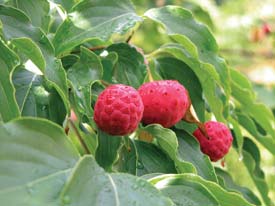 Dogwood fruit appears in late summer.
Dogwood fruit appears in late summer.
Featured Tree: Kousa Dogwood (Cornus kousa)With its attractive foliage and brilliant fall color, it’s no wonder that almost every Northwest garden contains a Dogwood. Spectacular white or pink blossoms and handsome bark make it an all-season tree. However, many dogwood varieties can develop the dreaded anthracnose fungus disease that kills blossoms, blights foliage and causes severe leaf drop due to wet springs. Anthracnose is the major cause for the decline in our Pacific Northwest stands. While many gardens contain the traditional Pink Dogwood (Cornus florida) the true hero is the disease-resistant Kousa Dogwood. Native to Japan and Korea, this dogwood grows slowly to 20 feet in height and width. It has a dense spreading and horizontal growth habit. The smooth gray-brown bark becomes mottled with white blotches, and becomes more ornamental as it ages. It flowers in late June with an extended four to six week flowering period. (Dogwood Fact: The flower petals are actually modified leaves called bracts. The four bracts surround the inconspicuous true flowers.) The creamy white, narrow, three-inch long bracts have sharp pointed tips. In late summer, red fruits as large as raspberries appear and hang below the branches. Lustrous medium green leaves turn a scarlet autumn color. Dogwoods prefer moist, well-drained, acidic soils in partial sun. They need occasional summer irrigation to help prevent leaf scorch. Most Kousa dogwood selections have white flowers, however there is a pink variety called “Satomi”. If a dogwood is a “must have” in your garden, the Kousa is a great small specimen tree with four season appeal. Austin Family Award ReceivedBy Terrill Collier At Collier Arbor Care, we work hard to emphasize the “family” in this second generation family business. For that reason, we’re especially proud to have received one of the 2006 Excellence in Family Business awards from the Oregon State University (OSU) Austin Family Business Program. 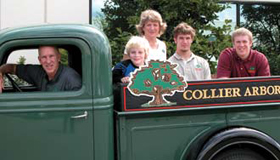
Terrill, Quentin, Janet, Brandon, and Logan Collier. The entire Collier family is involved in Collier Arbor Care, as they have been since my dad, Ray Collier, started the business in 1937. In 1981, I took over from Ray as president. Today, my wife Janet is vice president. Our two oldest sons Brandon, 18, and Logan, 17, have been working on crews or in the office during summers for several years. Even our youngest, Quentin, 8, has gotten involved accompanying me on outings such as the Friends of Trees planting we sponsored earlier this year. Dad started Collier Arbor Care with a third grade education. Through continuous and rigorous self education (he continuously queried horticultural experts), he became the go-to expert on ornamental tree and shrub problems. To some extent this award is a tribute to his commitment to honesty and hard work which grew the business and inspired me to get a degree in entomology pest management from OSU. Ray Collier passed away last year at the age of 96. I wish he could have seen this award, he would have been quite proud. Our company will be honored at the Austin Family Business Award banquet at the Oregon Zoo on November 16. |
|
Home |
Services |
The Arbor Advisor |
Garden Calendar |
About Us |
Fact Sheets |
Contact Us |
Site Map Collier Arbor Care Portland 503-722-7267 Vancouver (360) 693-6056 Site contents and design ©2013 Collier Arbor Care |
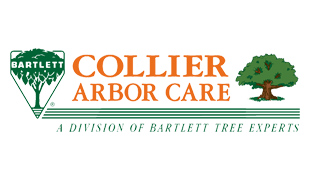






 top »
top »